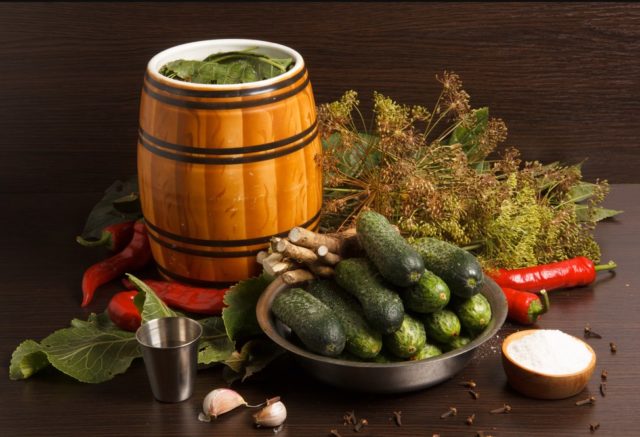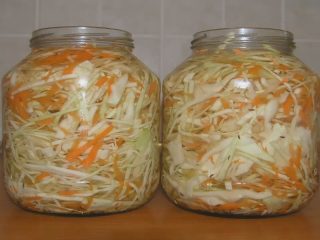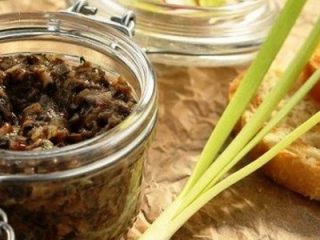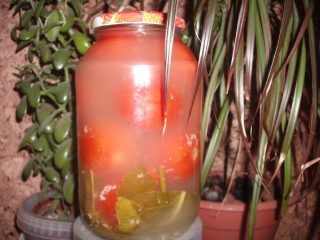Content
- 1 How to ferment cucumbers in a barrel
- 2 Traditional recipe for cucumbers pickled in a barrel
- 3 How to ferment cucumbers for the winter in a barrel with horseradish and currant leaves
- 4 Cucumbers pickled in a barrel for the winter with tarragon
- 5 Pickled cucumbers with dill and garlic in a barrel
- 6 Cucumbers fermented in a barrel with cherry and horseradish leaves
- 7 How to ferment cucumbers with mustard seeds in a barrel for the winter
- 8 Cucumbers pickled for the winter in a barrel with horseradish root and hot pepper
- 9 Cucumbers like barrels, pickled in a bucket
- 10 How to ferment cucumbers in a bucket of bread
- 11 Cucumbers fermented in a bucket with oak leaves
- 12 How to ferment cucumbers in a bucket in their own juice
- 13 Why do cucumbers pickled in a barrel or bucket become soft?
- 14 Storage rules
- 15 Conclusion
Preparing large volumes of vegetables for the winter requires special preparation methods and large containers. Barrel pickled cucumbers are the most important dish of Russian cuisine. For several centuries it has remained one of the hallmarks of the country’s culinary culture.
How to ferment cucumbers in a barrel
Each housewife carefully keeps her secrets of preparing this traditional dish.Depending on the desired result, you can get cucumbers with a dense structure, as well as tender and crunchy vegetables. Strict adherence to all recipe instructions is a guarantee of an excellent finished dish.
First you need to choose the right cucumbers. For pickling, it is best to use specimens freshly picked from the garden. However, given the large amount of the required starting product, you can take vegetables that are 3-4 days fresh. Almost all varieties of plants whose pimples have black dots are suitable for pickling.
A mandatory procedure before fermentation is pre-soaking in cold water. This guarantees that the dish will receive additional crunch in the future, and also eliminates possible bitterness. Cucumbers are placed in a large container with water for 4-6 hours. The liquid should be as cold as possible. If desired, you can add a little ice to it.
Another important ingredient when preparing pickled barrel vegetables is salt. To ensure the correct percentage of its content in the finished snack, it is best to use a large stone one. “Extra” salt is not suitable due to its too fine structure. You should also refrain from iodized and sea water - they activate fermentation processes.
The most creative part of preparing pickled cucumbers is the use of a variety of spices and additives.Depending on additional ingredients, the taste of the finished product can change dramatically. Many housewives use dill, garlic, thyme and tarragon for fermentation. Currant and cherry leaves are actively used. One of the most popular additives is horseradish root and shoots - they make the brine cleaner and protect it from possible mold.
Is it possible to ferment overgrown cucumbers in a barrel?
Fruits of almost any degree of maturity are suitable for pickling. Even if the cucumbers have grown too large and have thick skins, you can still get a great finished product. It is best to ferment large specimens together - this will guarantee uniform salting.
As with regular cucumbers, overgrown cucumbers are prepared according to almost the same recipe. The only difference is a slightly larger amount of salt used and an increased cooking time. Due to their appearance, large fruits that are ready to be fermented in a barrel are not served whole, but are cut into several parts.
Is it possible to ferment cucumbers in a plastic barrel or bucket?
If it is not possible to use traditional wooden barrels, you can make do with easily accessible plastic containers or stainless steel buckets. Such containers can guarantee the absence of foreign odors and tastes in the finished product. In addition, you can use containers of the required volume depending on the initial amount of product.
Plastic barrels, metal buckets and their lids must be prepared before pickling cucumbers. To do this, they are washed twice with a soda solution.Afterwards they need to be scalded with boiling water and wiped dry.
Preparing a barrel for fermentation
A barrel is the most popular container for preparing pickled cucumbers. Oak is best suited for recipes - it contains special compounds that act as preservatives and also prevent the formation and spread of mold. If you don’t have an oak barrel, you can use a linden one.
Before you start harvesting, it is important to properly prepare the container. If the barrel has not been used before, then it is necessary to remove tannins from its walls, which can spoil the taste of pickled cucumbers. If the container has been previously used for preparing pickles, it is necessary to thoroughly clean it of traces of previous use. Traditionally, there are 3 stages of preparing barrels - soaking, washing and steaming.
Soaking new wooden utensils takes 2-3 weeks. The water needs to be changed every couple of days to avoid a musty smell. As soon as it stops being painted in darker tones, you can proceed to the next stage. For previously used barrels, a different method is used - water with bleach dissolved in it is poured into them for an hour.
After the soaking procedure, the pickling containers must be thoroughly washed. In addition to running water, you can use a light solution of soda - it perfectly helps fight dirt. For more thorough washing, iron brushes are used - they allow you to remove even stubborn food residues.
Steaming cucumbers before pickling is analogous to traditional sterilization.To do this, place wormwood, juniper, and mint at the bottom of the container and pour several buckets of boiling water over them. The barrel is tightly closed with a lid and left until the water cools completely.
Traditional recipe for cucumbers pickled in a barrel
The simplest method of preparing vegetables for the winter uses a minimum set of ingredients. Pickled cucumbers turn out very tasty and crispy, and the absence of additional spices allows you to enjoy the pure taste of the product. To prepare the snack use:
- 50 kg of medium-sized cucumbers;
- 3.5 kg of coarse salt;
- 1 kg dill;
- 5 liters of water.
Dill greens are divided into 2 equal parts. One of them is placed at the bottom of the barrel. Half of the cucumbers are placed on top of it. They are sprinkled with the remaining dill, after which the second part of the vegetables is laid out. Cucumbers are poured with saline solution and left for 2-3 days at room temperature. As soon as the process of active fermentation begins, the barrel is sealed and put away for a month in a cold room, the temperature in which varies from 1 to 3 degrees.
How to ferment cucumbers for the winter in a barrel with horseradish and currant leaves
Barrel pickled vegetables according to this recipe turn out incredibly juicy and crispy. The horseradish leaves give them a slight piquancy, and the currants add a wonderful aroma. To prepare barrel cucumbers according to this recipe you need:
- 100 kg of main ingredient;
- 6-7 kg of table salt;
- 1 kg of currant leaves;
- 1 kg of horseradish leaves;
- 10 liters of liquid.
Some of the greenery is placed at the bottom of the oak barrel. Half of the previously soaked cucumbers are placed on top of it. Then another layer of crushed currant and horseradish leaves is laid out, after which the remainder of the main ingredient is added to the barrel.The entire contents are filled with saline solution and lightly pressed under pressure.
After a couple of days, the barrel cucumbers will begin to ferment. After this, the oppression is removed, the container is hermetically sealed with a lid and sent to the cellar or basement. After 1-2 months, the barrel pickled cucumbers will be ready. The average shelf life of such a product is 1 year - exactly until the next harvest.
Cucumbers pickled in a barrel for the winter with tarragon
Tarragon greens have an indescribable aroma that is transferred to vegetables. It is best to combine tarragon with dill and horseradish leaves. Cucumbers pickled in this way will not leave any gourmet indifferent. To prepare this barrel snack you will need:
- 100 kg of fresh vegetables;
- 1 kg of horseradish leaves;
- 1 kg dill;
- 1 kg tarragon;
- 10 liters of water;
- 6 kg of coarse salt.
The greens are mixed and divided into 3 parts. Cucumbers are placed in a barrel in 2 layers so that each of them is surrounded by aromatic herbs. After this, a salt solution is poured into the barrel. 2-3 days after pouring, pickled vegetables will begin the process of natural fermentation. At this point, the barrel must be tightly covered with a lid and stored in a cool room for several months.
Pickled cucumbers with dill and garlic in a barrel
Barrel vegetables can be prepared with more traditional ingredients. Garlic in combination with dill gives pickled cucumbers a powerful aroma and a bright piquant taste. This dish is perfect for noisy winter feasts.
To prepare it you need:
- 100 kg of fresh cucumbers;
- 10 liters of water;
- 7 kg of coarse rock salt;
- 2 kg garlic;
- 1 kg of dill umbrellas.
Peel the garlic, cut each clove lengthwise into 2 parts and mix them with dill. The resulting mixture is used to prepare fermented barrel cucumbers as layers between two parts of the main ingredient. When the container is filled with vegetables, the prepared saline solution is poured into it.
The barrel of cucumbers is left in a room at room temperature. After a few days, the first traces of fermentation will appear in it. Immediately after this, it must be tightly sealed and stored in a cool place. Pickled barrel cucumbers will be ready after 5-6 weeks.
Cucumbers fermented in a barrel with cherry and horseradish leaves
Cherry leaves are a natural source of substances beneficial to the body. In addition, they significantly improve the structure of barrel pickled cucumbers, making it denser and crispier. In combination with horseradish, they provide excellent taste and aroma of the finished dish.
To prepare this snack you will need:
- 100 kg of main ingredient;
- 1 kg of cherry leaves;
- 7 kg salt;
- 1 kg horseradish greens.
First you need to prepare a saline solution that will be used for further fermentation. To do this, salt is mixed in water at the rate of 7 kg of product to 10 liters of liquid. It is best to use hard spring water - it ensures that the finished product will be very crispy.
Future pickled cucumbers are laid out in layers, each covered with a sufficient amount of greenery. After this, a saline solution is poured into them. The barrel is left for a couple of days in a warm room. After fermentation begins, it is sealed and placed in a cold basement or cellar. After 1-2 months, pickled cucumbers will be ready.
How to ferment cucumbers with mustard seeds in a barrel for the winter
Mustard seeds are an excellent addition when preparing homemade preparations. It introduces small aromatic and flavor notes, and also makes the structure of barrel cucumbers more dense.
To prepare this fermented snack you will need:
- 100 kg of cucumbers;
- 6-7 kg of salt;
- 10 liters of water;
- 500 g mustard seeds;
- 1 kg dill;
- 20 bay leaves.
As in other recipes, the main ingredient is laid out in layers, alternating them with a mixture of herbs and spices. After this, the future barrel pickled cucumbers are filled with a saline solution at the rate of 6-7 kg of salt per 10 liters of water. After 2 days, traces of fermentation will appear in the container, which means that the barrel must be tightly closed with a lid and stored in a cold room. Barrel cucumbers will be completely ready 1 month after the start of fermentation.
Cucumbers pickled for the winter in a barrel with horseradish root and hot pepper
Fans of spicy dishes can add additional ingredients to the recipe and get a great barrel snack. Horseradish root gives cucumbers tartness and a powerful aroma. Depending on the consumer’s taste preferences, the level of spiciness can be leveled by changing the amount of pepper added.
On average, per 100 kg of the main ingredient you will need:
- 500 g hot capsicum;
- 500 g horseradish root;
- 1 kg dill;
- 7 kg salt.
Horseradish is peeled and grated on a coarse grater. The hot pepper is cut lengthwise, the seeds are removed and divided into several pieces. Horseradish and chili are mixed with finely chopped dill. The resulting mixture is used for layers between cucumbers. The filled barrel is filled with 10 liters of saline solution.
After a few days, active fermentation will begin in the barrel.At this time, it must be hermetically sealed and placed in a fairly cool place with a temperature of 1-4 degrees. Pickled cucumbers will be ready after 1 month, but it is best to use them in the winter months - the taste of the product will be fuller and more multifaceted.
Cucumbers like barrels, pickled in a bucket
The lack of a large wooden barrel should not put home-cooking enthusiasts in a bind. A bucket made of food-grade plastic or stainless steel is perfect for preparing delicious pickled cucumbers. For this recipe you need:
- 8 kg of fresh cucumbers;
- 3 heads of garlic;
- 6 liters of water;
- 10 cherry leaves;
- 10 currant leaves;
- 10 dill umbrellas;
- 12 tbsp. l. coarse salt.
Place half of the greens mixed with peeled garlic at the bottom of a plastic bucket. After this, cucumbers are placed there, which are covered with the second half of the leaves on top. The fruits are filled with saline solution. The bucket is left in a warm room for 2-3 days. After fermentation begins, the bucket is covered with a lid and put into a cold room for further fermentation. After a month, the pickled cucumbers will be ready.
How to ferment cucumbers in a bucket of bread
The original recipe for making pickled vegetables with the addition of bread is one of the traditional dishes of the Siberian region. The product prepared in a bucket is not inferior in taste to the barrel version. The bread improves natural fermentation and also imparts subtle aromatic notes and a light yeasty taste. To prepare 6 kg of cucumbers you need to take:
- 300 g black bread;
- 300 g salt;
- 200 g sugar;
- 5 liters of liquid;
- 5 dill umbrellas;
- 2 tbsp. l. mustard seeds.
Cucumbers are placed in a food-grade plastic bucket mixed with dill and mustard.A solution prepared from salt, sugar and water is poured into them. The bread is cut into pieces and placed in a gauze bag. It is immersed in a bucket, which after 2 days is put away in a cool place. In a month, the pickled cucumbers will be ready. The shelf life of such a product is on average 3-4 months.
Cucumbers fermented in a bucket with oak leaves
Oak leaves contain a large amount of tannins, which make the structure of the finished dish more dense and crunchy. Vegetables fermented in this way are very similar in consistency to barrel vegetables.
To prepare the snack you will need:
- 7 kg of main ingredient;
- 20 oak leaves;
- 500 g salt;
- 6 liters of water;
- 10 cherry leaves;
- 5 dill umbrellas.
The bottom of a plastic bucket is lined with half the leaves, dill and one third of the salt. Cucumbers are laid on top in a dense layer, sprinkled with the remaining seasonings and filled with water. As soon as fermentation begins in the bucket, it should be covered with a lid and put in a cold room for further fermentation.
How to ferment cucumbers in a bucket in their own juice
The process of preparing a delicious fermented snack without adding water, although it takes a little more time, its result will also not leave any lover of homemade preparations indifferent. Additional juice secretion occurs due to the applied pressure.
To prepare 8 kg of cucumbers in this way you will need:
- 600 g salt;
- a large bunch of dill;
- 15-20 currant leaves.
Place 1/3 of all the salt and 1/2 of the leaves and herbs on the bottom. Place half of the cucumbers on top. They are sprinkled with another third of salt. Then lay out a layer of cucumbers again, which is covered with the remaining herbs and salt. The vegetables are pressed down from above with pressure.As soon as abundant juice secretion begins, the bucket is moved to a cool room for 2 months. Cucumbers fermented in this way are less crunchy than traditional cucumbers, but their taste is in no way inferior to them.
Why do cucumbers pickled in a barrel or bucket become soft?
Violation of the cooking technology can lead to significant damage to the finished product. One of these violations is the excessive softness of pickled cucumbers and the almost complete absence of crunch. The most common problem is elevated room temperature.
One of the main points of each of the recipes is to move the container with cucumbers to a cooler place. If you are 2-3 days late, fermentation will become uncontrollable, which will lead to a complete loss of the dense structure. It is important that the temperature in the cellar or basement does not rise above 3-4 degrees.
What to do to prevent mold in a barrel of pickled cucumbers
The appearance of mold can upset any housewife. This is often due to improper storage conditions for pickled cucumbers. The main cause of mold is the entry of clean air into the container with vegetables. To avoid this, you need to make sure the lid is tight. For additional air protection, you can cover the lid with another layer of gauze.
There is another method to get rid of mold. When the cucumbers are in a warm room, you need to lower a long wooden stick into them once a day.This will get rid of gases accumulated in the lower part of the barrel, which can lead to accelerated mold development.
Storage rules
If the necessary conditions are met, pickled cucumbers can be stored for quite a long time. Depending on the chosen cooking recipe, the shelf life of the finished product can be 1.5-2 years. To achieve such results, the room in which the container with cucumbers is located must meet several simple requirements.
The temperature in it should not fall below 0 and rise above 3 degrees. The room should not be exposed to direct sunlight and there should be no sources of open air. A deep cellar in a personal plot or summer cottage is best suited for these purposes.
Conclusion
Barrel pickled cucumbers will delight housewives with their excellent taste and special juiciness. In suitable conditions, such a dish can be stored all winter. A wide variety of recipes using additional ingredients will allow every housewife to create a unique culinary masterpiece.






















